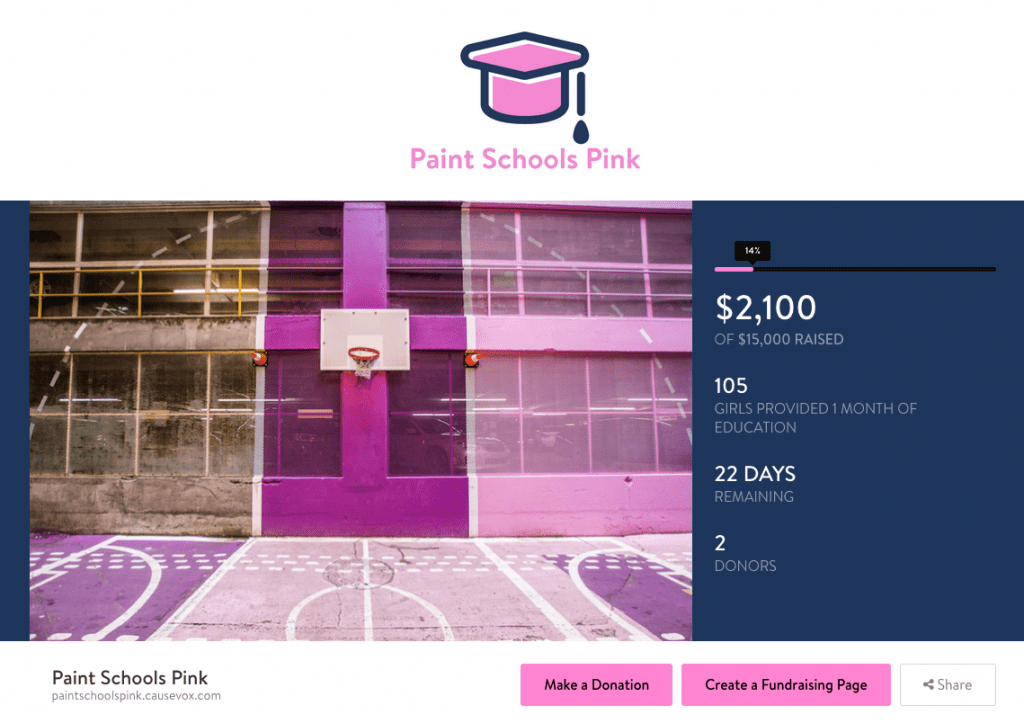Launching a peer-to-peer fundraising campaign entails a bit of preparation.
You have to set up your campaign, create your content, promote it to your audience, and get fundraisers engaged.
And once your fundraisers are engaged, they need to stay engaged.
After seeing thousands of peer-to-peer fundraising campaigns on CauseVox, I’ve noticed there’s a small feature that’s generally overlooked, but is potentially the biggest driver of fundraiser engagement after they’ve created their page.
This is the welcome email for personal fundraisers.
The welcome email on CauseVox is sent out to fundraisers immediately after creating their page, and it’s a huge opportunity to welcome them and set them up for fundraising success.
Jump to the Welcome Email Template for personal fundraisers.
Here’s a look at an example of a good welcome email from my demo Paint Schools Pink campaign.

Welcome to the Paint Schools Pink Campaign!
You’re a part of a group of people that are working to provide education for girls all over the world, and we couldn’t be more excited to have you on the team.
You’re helping girls like Kalita, a girl who could have been married off at 12, get an education and have a brighter future. Kalita is now training to be a police officer to help take care of her community.
Education can change the life of a girl forever.
For $240, you can send a girl to school for a year. And you can help be part of reaching our goal to send 30 girls to school this year
Ready to start? Set your own academic goal that you want to accomplish, and work towards fundraising while you progress! A couple of common goals are:
- Take a class to learn something you’ve always wanted to learn
- Read one or a number of books before the campaign ends
But you can choose any challenge you’d like! Once you decide on your goal, kick it off by writing a blog post about it. As you work towards your goal, keep your supporters updated with more blogs!
To help you promote your page easily, we’ve compiled a toolkit you can use with pre-written blog posts, images, a promo guideline calendar, and more to help you get the word out about your page.
Want a little more info on the campaign? Find our campaign overview and details here. If you have any questions, please reach out to carrie@paintschoolspink.org
Login to your fundraising page anytime by going to https://paintschoolspink.causevox.com/login
Best of luck!
Best,
Carrie
Based on this example, here’s the 6 top components of a welcome email that rallies peer-to-peer fundraisers.
1) A Warm Welcome To Your Community
When someone signs up to fundraise for you, they may have never fundraised before or have worked with your organization in this capacity, and they likely feel a little unsure of their fundraising capabilites.
The best thing you can do to start off your fundraiser welcome email, is well, welcome them! You can do this in 3 ways:
- Make them the champions of the cause by reassuring them they’re making a difference.
- Show appreciation for their participation.
- Make them feel part of a community.
In the example above, all this is accomplished in the header and the first sentence.
Welcome to the Paint Schools Pink Campaign!
You’re a part of a group of people that are working to provide education for girls all over the world, and we couldn’t be more excited to have you on the team.
By assuring your fundraisers that they’re important to you, important to the cause, and aren’t working alone, you’re helping them to feel empowered to fundraise for you.
2) Tell A Brief Story
With all our talk about storytelling, it may sound like we’re advocating for big, long, emotion-filled tales.
But you can tell a story in two sentences, and putting the right story in your welcome email can help your fundraisers remember why they’ve committed to fundraise for you, and get them started with an impact-driven mindset.
In the example from my demo campaign above, the welcome email reads:
“You’re helping girls like Kalita, a girl who could have been married off at 12, get an education and have a brighter future. Kalita is now training to be a police officer to help take care of her community.”
In these two sentences, a character is introduced, the conflict is explained, your solution for the conflict is presented, and there’s a happy, inspiring ending. And it’s all framed to make the fundraiser the hero of the story.
In your welcome email, take a moment to tell a story that makes the fundraiser the hero of the cause, and they’ll be inspired and compelled to fundraise for you.
As a bonus tip, link it to the full story written out in a blog post on your site, so they can get further engaged, informed, and inspired by the story.
3) Reiterate Your Goals
Just because a fundraiser signs up to fundraise doesn’t mean they’re completely aware of what you’re looking to accomplish with this campaign.
While your goals for your campaign may be listed on your campaign, reiterate what specific dollar amounts raised will contribute to a unit or units of impact. These specific units of impact can and should be the same as your donation tiers or your impact metric.
In the Paint Schools Pink example it reads, “For $240, you can send a girl to school for a year. And you can help be part of reaching our goal to send 30 girls to school this year.”
By breaking your goal down into units of impact tied to specific dollar amounts, you’re able to help your fundraisers get a better grasp on exactly what it is the funds they raise are accomplishing, which can drive them to fundraise more.
Additionally, by stating your overall goal, whether that’s a dollar amount, or preferably an impact-driven goal, you’re including your fundraiser in the picture, so they know what they’re working towards on a broader scale.
4) Challenge Your Fundraisers
As a general peer-to-peer fundraising best practice, it’s best to challenge your fundraisers to get them invested in the campaign.
This challenge can be anything: a physical challenge, a competition, a challenge the fundraiser creates for themselves (aka a DIY fundraising campaign), or a simple challenge to raise a certain amount.
Whatever your campaign’s challenge may be, the welcome email is the perfect place to feature it.
Your welcome email is your first chance to really inspire your fundraisers to set high goals for themselves and challenge them to meet it.
In the example above, the welcome email reads:
“Ready to start? Set your own academic goal that you want to accomplish, and work towards fundraising while you progress! A couple of common goals are:
-Take a class to learn something you’ve always wanted to learn
-Read one or a number of books before the campaign ends
But you can choose any challenge you’d like! Once you decide on your goal, kick it off by writing a blog post about it. As you work towards your goal, keep your supporters updated with more blogs!”
In a brief but detailed way, the email lays out the challenge for the fundraiser so they’re aware of what the challenge entails. When considering highlighting your own challenge in your welcome email, you’ll want to include:
- A brief description of your challenge
- An example of DIY challenges they can be inspired by (if applicable)
- Any incentives you’re offering your fundraisers
By providing the details of your campaign’s challenge in the welcome email, your helping your fundraisers engage with your campaign on a personal level right from the start.
5) Include Promotion Tools And A Campaign Overview
Your personal fundraisers don’t have the professional fundraising background you do, so they’re likely not confident in their fundraising capabilities
But that doesn’t mean you can’t prepare them to fundraise like a pro.
In your welcome email, it’s in your best interest to link a campaign overview and toolkit that fundraisers can use to help promote your campaign.
A campaign overview is generally a one pager and should include any information they need to know about the campaign, such as cause-related statistics, any specific dates and locations they need to know, and more detailed information about the inner-workings of your campaign/organization.
A toolkit on the other hand is a page, typically a blog post on your site, that includes any promotional materials that fundraisers can really simply copy and paste into different social channels to promote their campaign. A toolkit typically includes:
- Your organization’s logo and your campaign logo, if you have one.
- A pre-written email template they can send out to their networks.
- Images and infographics they can attach to emails, social media posts, etc.
- Pre-written social media posts.
- A communications calendar to guide them on when and how often to promote their page.
For more information on creating a campaign overview and toolkit, view our guide Creating A Toolkit For Nonprofit Fundraising.
With these tools at their disposal, they’ll be equipped to easily promote their page for you, which helps set them up for success (and therefore sets you up for success too).
6) Provide The Direct Login Link And A Contact Email Address
In a practical sense, everything you’ve done to prepare your fundraiser is all for naught if they can’t figure out how to get back into their account.
In your welcome email, provide the direct link to help them login quickly and easily. Your direct link is in the format of yourcampaignsite.causevox.com/login.
Providing this will make it simple for them to login the next time they’d like to make an update.
Additionally, even if you do provide a campaign overview and toolkit, fundraisers might have some questions for your team, and if it’s hard to find a person to talk to, you could be at risk of losing a potential successful fundraiser.
We recommend assigning one person on your nonprofit team as the point of contact for fundraisers, and including their email address in the welcome email.
This helps fundraisers feel confident that they can reach someone at your nonprofit, in case they hit a bump in the road.
Ready to write a welcome email that will help rally and equip your fundraisers? Set up your welcome email for your campaign.
Welcome Email For Personal Fundraisers Template
Need more guidance on creating a default a welcome email for personal fundraisers? Here’s a template you can copy + paste, and tailor for your organization:
Hi {{first_name}},
Thank you so much for joining our fundraising community for {{title}}!
Because of you, (INSERT IMPACT STATEMENT).
Here’s the details for the fundraiser:
- The fundraiser runs from (INSERT START DATE – INSERT END DATE)
- (INSERT MORE DETAILS SUCH AS IMPORTANT DATES, TIMES, and LOCATIONS)
- (IF APPLICABLE, INSERT A LINK TO YOUR FUNDRAISER TOOLKIT)
- If you have any questions, please don’t hesitate to reach out to us at (INSERT EMAIL ADDRESS)
Thanks again for joining us to fundraise for (INSERT IMPACT STATEMENT)!
The Team @ (INSERT ORGANIZATION NAME)



